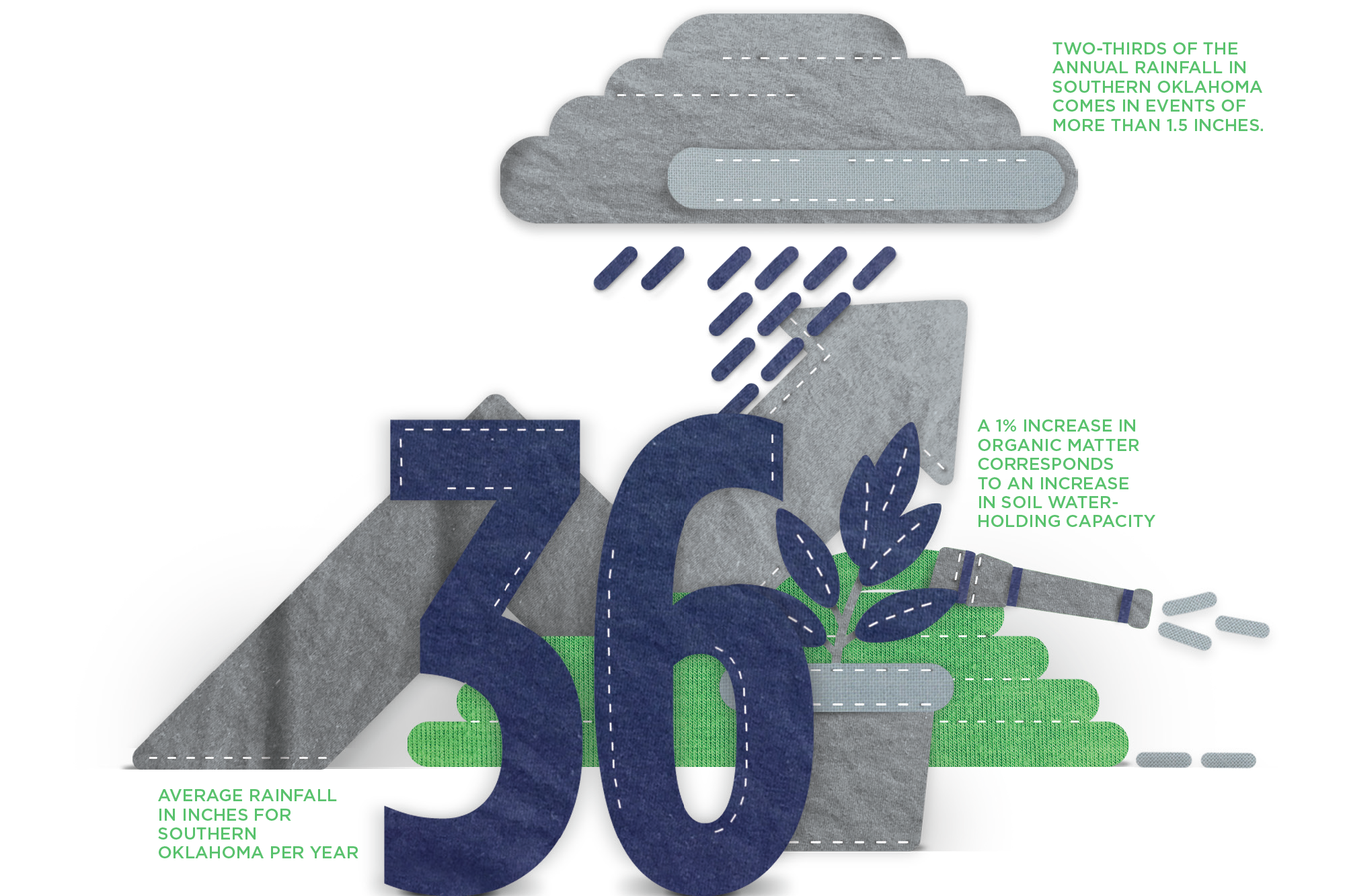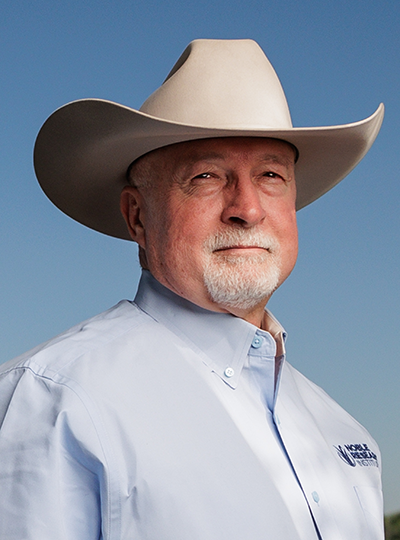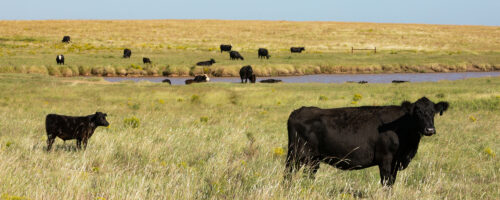Not All Rainfall Is Effective
Generally speaking, a 1% increase in organic matter corresponds to an increase in soil water-holding capacity by about 20,000 gallons of water per acre.
The old adage, “We are never more than three weeks away from a drought,” is commonly used by producers here in the southern Great Plains. However, depending on the management of the property, drought may be closer than some think and considerably further out for others. A 3-inch rain may result in different outcomes for different producers even if the pastures and soils are similar. The observable variance is often the results in differences of “effective” rainfall.
Effective vs. Total Rainfall
Effective rainfall is the moisture that infiltrates into the soil following a rainfall event. Total rainfall is what fell on a property; effective rainfall is what went into the soil.
Too often, much of the rain from a good rainfall event ends up running off the area it fell upon and traveling off the property and downstream. The more total rainfall becomes effective rainfall, the greater the potential for forage and subsequently livestock production and the greater the resiliency of the pastures to withstand short- and longer-term drought conditions.

Build Organic Matter to Capture More Water
So what are the factors that influence how droughty our soils and pastures may be?
Much of the variance observed in effective rainfall and the lack of drought resiliency of pastures can be attributed to a lack of water-holding capacity. Water holding capacity is influenced by soil type, previous management and organic matter in the soil.
There is little you can do about the soil types of your property. Inherently, some soil types hold more water than others. For example, good loam and clay loam soils hold more water than a sandy soil. However, you do have influence on other variables that directly affect the amount of organic matter that accumulates in and on the soil.
There is a correlation between soil organic matter and water-holding capacity. The greater the amount of organic matter in and on the soil, the greater the water-holding capacity and the more drought-resilient soils and pastures will be regardless of the soil type.
No. 1 Recommendation: Keep Soil Covered
Of these five principles, keeping the soil covered is usually the most important principle to begin increasing soil organic matter.
It is not only important to maintain cover, it is important to consider the type of cover. Both live plants and plant litter are important components of cover. In an ideal situation:
There is never bare ground in the pastures and the plant material growing in and on the soils are healthy, productive and managed so that there is plenty of plant material remaining during the growing and dormant seasons.
Adequate residues are maintained following grazing events and across all season allowing for some plant litter to mature, deteriorate with age and accumulate at the soil surface.
With productive grasses, root systems are robust, with proper turnover and regrowth of roots occurring simultaneously with the forage production.
To increase the amount of effective rainfall, a producer needs to manage their pastures in such a manner that is complementary to the soil health principles.
Grazing livestock are managed so that plants are never/rarely grazed severely and receive adequate recovery before being re-grazed.
With this description of proper management to enhance organic matter in and on the soils, a producer incorporates other soil health principles too: soil disturbance is optimized, grazing livestock are incorporated and a growing root is in the soil at all times. In many instances, it means plant diversity contributes as well. To increase the amount of effective rainfall, a producer needs to manage their pastures in such a manner that is complementary to the soil health principles.
Runoff Is Common With Multi-Inch Rains
Consider for a moment the total average rainfall for south-central Oklahoma is about 35-36 inches annually. The variation of rainfall events ranges from trace amounts to an occasional event in excess of 5 inches.
In a favorable year, it is not unusual for the region to experience multiple rain events greater than 3 inches in a growing season. In such years, significant runoff occurs. This fills ponds and lakes — a worthy benefit — but once the pond fills, the remaining moisture is lost.
So how much rain falls on our pastures before it begins to run off? How much of the total rainfall is effective? Unfortunately for many producers, most pastures incur runoff with multi-inch rainfall events.
Let’s take a look at an anecdotal example:
A producer with an annual rainfall of 36 inches observes runoff routinely with rains of more than 1.5 inches. Looking at the Oklahoma Mesonet’s monthly rainfall reports for past few years, we observe about two-thirds of the annual rainfall for the area comes in events of more than 1.5 inches. Subsequently, about 12 inches (one-third of 36 inches) of rain occurs from events less than 1.5 inches and 24 inches (two-thirds of 36 inches) comes from larger rain events (more than 1.5 inches).
On average, we see about eight large rainfall events annually. Assuming that any rainfall more than 1.5 inches will runoff, the effective rainfall from these eight events is 12 inches (8 rain events × 1.5 inches). The total effective rainfall from 36 inches of total annual rainfall for this producer is about 24 inches (12 inches from rain events of less than 1.5 inches and 12 inches from rains of more than 1.5 inches). This example is not that unusual.

How to Gain 20,000 More Gallons of Water
Most soil samples that come through Noble Research Institute’s soil testing facility are near or below 1% organic matter. Therefore, it is easy to conclude that only about 24 inches of our annual rainfall is effective for some if not many 1% organic matter soils in south-central Oklahoma.
Generally speaking, a 1% increase in organic matter corresponds to an increase in soil water-holding capacity by about 20,000 gallons of water per acre or about seven-tenths of an inch of rain. By increasing soil organic matter from 1% to 2%, more water infiltrates into the soil and less runoff occurs.
When applied to our previous example, the point of runoff increases from 1.5 inches of rain to 2.2 inches of rain. Only about 40% of rain events are in excess of 2.2 inches, and there are generally about five of those annually. Effective rainfall increases to 21.6 inches (36-inch annual rainfall × 60%) plus 11 inches (2.2 inches x 5 events) equals 33.6 inches.
A 1% increase in soil organic matter makes a significant difference in effective rainfall. In this example, it is a 40% increase. It is not difficult to interpolate a corresponding increase in forage production. In reality, it doesn’t always work that way since some rain occurs during the dormant season. However, if a 40% increase in effective rainfall produced only a 20-30% increase in production and carrying capacity, it would still be beneficial. Perhaps more importantly in the long-term, it would produce much greater resiliency in the soils and pastures making both less susceptible to droughts.
Imagine what an additional percent increase or two would do!



Comment